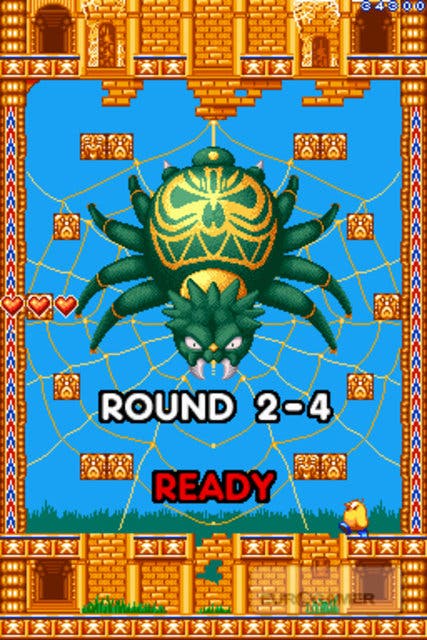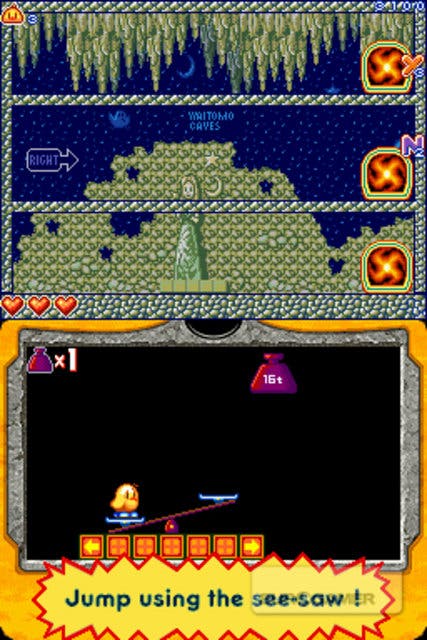New Zealand Story Revolution
Give it the bird?
Having attempted to 'revolutionise' Space Invaders, Bubble Bobble and Rainbow Islands, it was only fair that the Dreams studio should turn its attention to New Zealand Story.
Well, 'fair' is probably the wrong word. 'Expected' is more like it, given that the number of well-known Taito games it can re-make on the DS is starting to dwindle.
As Ellie pointed out rather nicely in her preview, the problem with updating fondly remembered classics is the developer's temptation to needlessly tinker with the formula. In particular, they just can't seem to resist shoehorning rubbish touch-screen controls into games that don't benefit from them.
Perhaps mindful of the stinging criticism applied to its previous efforts, Dreams has taken a more thoughtful, faithful approach to New Zealand Story. Luckily, the Japanese studio hasn't been foolish enough to remain completely faithful, though. If they did that, this would have been a particularly painful review to write.
Put the freshness back

As cute as it was, the 1988 arcade game was saddled with the kind of one-hit-death mechanics that make us want to shake and vac our eyeballs nearly two decades on. If that's what you want, then Taito Legends Power-Up will service your needs, with a perfectly emulated version of the original alongside numerous Taito curiosities. On the other hand, if you want retrogaming force-fed with game design sanity pills, then this is one of the better examples attempted.
Even the most cursory assessment demonstrates that the basis for the gameplay is pretty much the same as it always was - you still have to guide Tiki around platform-based levels looking for the key to your caged friends, you still fire arrows, you still grab hold of balloons and hop aboard craft and other vehicles to get around, and you still pick up all manner of random tat that the baddies leave behind. At the end of each group of four levels you'll meet a boss, shoot him to death and move onto the next world, and so on. Yes, the theme tune remains intact, no they haven't changed the 'look' of the game other than clean up the graphics (with sharper, more detailed backdrops, and better animation for instance), the worlds are the same (Auckland, Rotorua, Waitomo Caves, etc), the bosses are (apparently) the same (my memory's not what it was), but there are a ton of important refinements, differences and enhancements, to boot.
For a start, the cute Kiwi chick star of the show can double-jump, which instantly makes negotiating the spike and enemy laden environment a hell of a lot easier. Then you'll notice that there's a three-step heart-based health system, meaning that you don't die the second something fires an arrow at you (which is, after all, an awful lot). Then you'll discover your ability to aim your arrow shots in 360 degrees with the shoulder buttons, or fly when falling if you hammer the A button, or the Charge Shot by holding down the B button. Then you'll come across power-ups, like being able to freeze enemies in a block of ice, or set them on fire, or the one that equips Tiki with a sword and shield.
Restoration job

As a result, the whole game's is an order of magnitude more playable, and much more how you want it to be, with many of the good platforming ideas of the past two decades sympathetically grafted onto the core: Put it this way, if you were a huge fan of the original, there's not much that's going to disappoint you about this. It's 1988 brought up to date.
Ok, calm down. We're not saying this is awe-inspiringly brilliant, either. The levels are still chock full of about a gazillion spiky traps and endlessly respawning gits that still make progressing through levels something of a fraught affair.
And then there are the touch-screen bits.
Our chief whinge has to be the 'spot the difference' sections. On occasion, the game replicates the play area on the touch-screen, and tasks you with pointing to the one thing that's different (often in order to open a special portal to zap you to another part of the level). Doing that wouldn't be such an issue were it not for the difficulty in finding a third hand with which to touch the screen with while you're busily using your left hand to move and right to jump and fire. As soon as you remove either hand to point at the screen, you instantly get swamped with the aforementioned respawning gits and, at best, lose a chunk of health. Very often it means getting knocked to your doom and having to start over, which, as you can tell, isn't the most fun you can have ever. Worse still, if you lose a life, it randomly changes the location of the 'difference', extending the pain even more.
Touch of farce

The other touch-based activities aren't too bad, though, but still feel rather tacked on for the sake of it - like the tightrope mini-game, for example. Here, the gameplay flicks to a touch-screen mini-game where you have to help Tiki get across a tightrope by gently correcting his stance, touching the end of his balancing pole to do so. Trouble is, it's just too easy to be a worthy inclusion. Likewise, having to spin around a door handle on the touch-screen to open a door is, well, pointless. The See-Saw jump (where you have to place a weight above the opposite end of Tiki's see-saw to fire him up to the tops screen) is equally questionable; all of these are simple novelties, but once you've encountered them once, you start to wish you could just get on with the main event.
The four-player versus mode is, as expected, a bit of a light-hearted bolt-on inclusion, too. Touch the difference is a simple race to find the difference, but, frankly, extending the worst bit about the single-player game into a multiplayer game isn't smart. There's also a Tightrope race, which is, again, hardly going to have your mates desperate to have another go. There's a fishing one, too, where you have to guide the hook into a fish's mouth and then jump up and catch it once it's pulled out of the water, but it's hardly the zenith of handheld multiplayer gaming.
New Zealand Story Revolution, then. Worth getting? If you were a mad fan of the original, then you'll largely approve of the results of this sympathetic new version. If you're not old enough to care about geriatric remakes and simply want a good platformer for your DS, then it's a tough call. You won't know or care about the so-called 'improvements', and might just get irritated with how easy it is to die, and find some of the level design a little spiteful and old-hat. But, then again, in small doses, it's a game that finds its own old-school groove, and an enjoyable one for the most part. The touch-screen nonsense does it little favours, though, but luckily doesn't completely ruin the fun. Dreams and Rising Star are definitely on the right track with these remakes, but they still have a rather narrow appeal at a prohibitively high price.








